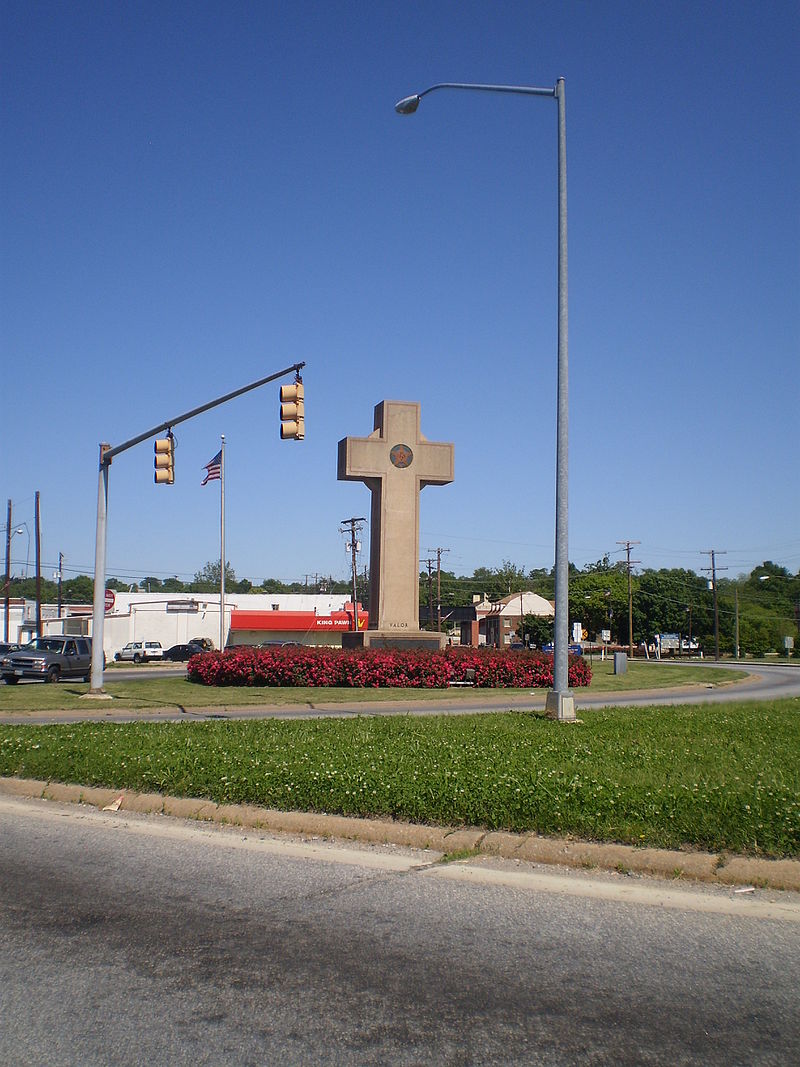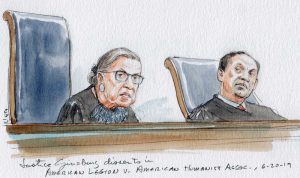Opinion analysis: Justices allow “peace cross” to stand (Updated)


Editor’s Note: this post was updated at 1:43 p.m.
For nearly a century, a 40-foot-tall cross has stood in what is now a traffic median in the suburbs outside Washington, D.C. Erected to honor 49 local soldiers killed in World War I, the cross’s presence on public land drew little attention until 2012, when a group of local residents filed a lawsuit in federal court. They argued that the cross, which is maintained by the state, violates the Constitution’s establishment clause, which prohibits the government from establishing an official religion or favoring one religion over another. Today the Supreme Court rejected that argument, with seven of the nine justices agreeing that the cross (and others like it) should be allowed to stand.

The ruling is the latest chapter in the debate over religious symbols in the public sphere. The justices confronted a similar case nearly 15 years ago, when they rejected a challenge to the display of a Ten Commandments monument on the grounds of the Texas state capitol. In that case, Justice Stephen Breyer provided the fifth vote to leave the monument in place, with his concurring opinion providing the governing rule. In 1971, the Supreme Court outlined a test – known as the “Lemon test,” after the case in which it was established, for courts to use to determine whether a law or practice violates the establishment clause: The law or practice is constitutional if it has a secular purpose, its principal effect does not advance or inhibit religion, and it does not create an “excessive entanglement with religion.”
But Breyer declined to use the Lemon test in the Texas case, explaining that there is “no single mechanical formula that can accurately draw the constitutional line in every case.” Breyer reasoned that although the Ten Commandments monument “undeniably has a religious message,” the state intended it to convey a secular message. Indeed, Breyer noted, no one had challenged the presence of the monument at the capitol for 40 years – which, he posited, suggested that the public regards it as part of a “broader moral and historical message reflective of a cultural heritage.”
Justice Samuel Alito wrote for the court today, in an opinion that once again eschewed the use of the Lemon test. Alito began by explaining that although the cross “came into widespread use as a symbol of Christianity” and continues to have that meaning today, it “has also taken on a secular meaning” in other contexts. In particular, Alito noted, the cross became a “central symbol” of World War I – which likely explains the choice to use a massive cross as the memorial for the Prince George’s County soldiers.

Alito then observed that, if the intent of the Lemon test had been to “bring order and predictability to Establishment Clause decisionmaking,” in practice the test had fallen short. This was particularly true, he noted, in cases – like this one – involving religious symbols or monuments. These symbols and monuments were often established long ago, making it difficult to identify their original purpose. And even when that original purpose can be identified, Alito continued, the purpose or the message conveyed by the monument may expand or change. He cited the example of the Notre Dame cathedral in Paris, describing it as both “fundamentally a place of worship” but also “inextricably linked with the very idea of Paris and France.” When this happens, Alito suggested, taking down a monument can be seen not as an act that restores neutrality, but instead as “aggressively hostile to religion.” Taken together, Alito concluded, these different considerations show that at least when the question is whether to keep religious monuments in place, rather than to put up new ones, there should be a presumption that the monuments are constitutional.
That presumption, Alito continued, applies here: Not only did the cross start off with the “added secular meaning” associated with World War I, but it took on “historical importance”: It reminds local residents of the conflict and the sacrifices that area soldiers made. On the other hand, there is no evidence that Jewish soldiers were either “deliberately left off the list on the memorial” or “included on the Cross against the wishes of their families.”
“The cross is a Christian symbol,” Alito concluded, “but that fact should not blind us to everything else that the Bladensburg Cross has come to represent. For some, that monument is a symbolic resting place for ancestors who never returned home,” while for others “it is a place for the community to gather and honor all veterans and their sacrifices for our Nation.” “For many of these people,” Alito stressed, “destroying or defacing the Cross that has stood undisturbed for nearly a century would not be neutral and would not further the ideals of respect and tolerance embodied in the First Amendment.”
Justice Stephen Breyer joined all of Alito’s opinion, but he also wrote a separate concurring opinion that was joined by Justice Elena Kagan. Breyer reiterated his belief that “there is no single formula for resolving Establishment Clause challenges.” Instead, he contended, the most important consideration in each case is “the basic purposes that the Religion Clauses were meant to serve: assuring religious liberty and tolerance for all, avoiding religiously based social conflict, and maintaining that separation of church and state that allows each to flourish in its separate sphere.”
Breyer may have wanted to signal that (at least as far as he was concerned) today’s holding was a relatively narrow one. “The case would be different” for him, he indicated, “if there were evidence that the organizers had deliberately disrespected members of minority faiths or if the Cross had been erected only recently.” “Nor do I understand,” he continued, “the Court’s opinion today to adopt a history and tradition test that would permit any newly constructed religious memorial on public land.” History can provide guidance, Breyer conceded, but the Supreme Court today allowed the cross to stand only after “considering its particular historical context and its long-held place in the community. A newer memorial, erected under different circumstances, would not necessarily be permissible under this approach.”
Justice Brett Kavanaugh also joined all of Alito’s opinion but had a separate concurring opinion. He expressed even stronger opposition to the Lemon test than did Alito’s opinion for the court. Contending that “the Court’s decisions over the span of several decades demonstrate that the Lemon test is not good law and does not apply to Establishment Clause cases in any of” five categories, Kavanaugh distilled from those cases a test that focuses on whether the practice at issue is coercive, along with (as relevant here) whether it is rooted in history and tradition. Because the cross meets both of those criteria, Kavanaugh agreed that the cross does not violate the Constitution and should be allowed to stand.
Kavanaugh then pivoted to express his “deep respect for the plaintiffs’ sincere objections to seeing the cross on public land” and his “sincere respect for the Jewish war veterans who in a friend-of-the-court brief “say that the cross on public land sends a message of exclusion.” Indeed, Kavanaugh acknowledged, the cross is a “deeply religious” symbol. “A case like this is difficult,” Kavanaugh wrote, “because it represents a clash of genuine and important interests.”
At the same time, Kavanaugh continued, the fact that the Supreme Court has allowed the cross to stand doesn’t mean that the plaintiffs can’t pursue other options to have the cross taken down. For example, he wrote, the Maryland legislature could require the cross to be taken down or it could give the land to a private entity. “These alternative avenues of relief illustrate a fundamental feature of our constitutional structure: This Court is not the only guardian of individual rights in America.”
Justice Elena Kagan joined most, but not all, of Alito’s opinion. But she wrote separately to note that, although she agreed “that rigid application of the Lemon test does not solve every Establishment Clause problem, I think that test’s focus on purposes and effects is crucial in evaluating government action in this sphere—as this very suit shows.”
Justice Clarence Thomas also would have allowed the cross to stand, but for a different reason: He believes that the Constitution’s establishment clause does not apply to the states at all. Even if it did apply to the states, he added, there would still not be any constitutional violation – either because the establishment clause only applies to laws passed by a legislature or because the clause requires actual coercion by the government. And he made clear that he would take what he regarded as “the logical next step and overrule the Lemon test in all contexts.”
Justice Neil Gorsuch also agreed that the cross should be permitted to remain in place, but he argued that the case should be dismissed, because the challengers do not have a legal right, known as “standing,” to bring a lawsuit. Simply being offended by the cross’s presence is not, Gorsuch contended, enough to justify the lawsuit. The idea that an “offended observer” can bring a lawsuit was, Gorsuch suggested, “invented” by the lower courts in response to the Lemon test, which Gorsuch described as a “misadventure”: “It sought a grand unified theory of the Establishment Clause but left us only a mess.”
Gorsuch was, however, also relatively skeptical about Alito’s emphasis in this case on the cross’s age, and he would take a broader view. How old, Gorsuch queried rhetorically, is old enough to qualify for the presumption that a religious monument does not violate the establishment clause – “what about the Star of David monument erected in South Carolina in 2001 to commemorate victims of the Holocaust?” For Gorsuch, “what matters when it comes to assessing a monument, symbol, or practice isn’t its age but its compliance with ageless principles. The Constitution’s meaning is fixed, not some good-for-this-day-only coupon, and a practice consistent with our nation’s traditions is just as permissible whether undertaken today or 94 years ago.”

Justice Ruth Bader Ginsburg read her dissent, which was joined by Justice Sonia Sotomayor, from the bench – a move that justices generally reserve for opinions expressing strong disagreement with the majority’s ruling. Ginsburg rejected the idea that the cross is merely a secular symbol of World War I: “The Latin Cross,” she wrote, “is the foremost symbol of the Christian faith,” and using it as a war memorial doesn’t change that. A history of the efforts to bury American war dead in Europe after World War I shows, Ginsburg argued, that the cross “was never perceived as an appropriate headstone or memorial for Jewish soldiers and others who did not adhere to Christianity.” By “maintaining the Peace Cross on a public highway,” she argued, the Maryland government “elevates Christianity over other faiths, and religion over nonreligion.”
This post was originally published at Howe on the Court.
[Disclosure: Goldstein & Russell, P.C., whose attorneys contribute to this blog in various capacities, is counsel on an amicus brief in support of the petitioners in this case. The author of this post, however, is not affiliated with the firm.]
Posted in Merits Cases
Cases: The American Legion v. American Humanist Association, Maryland-National Capital Park and Planning Commission v. American Humanist Association
